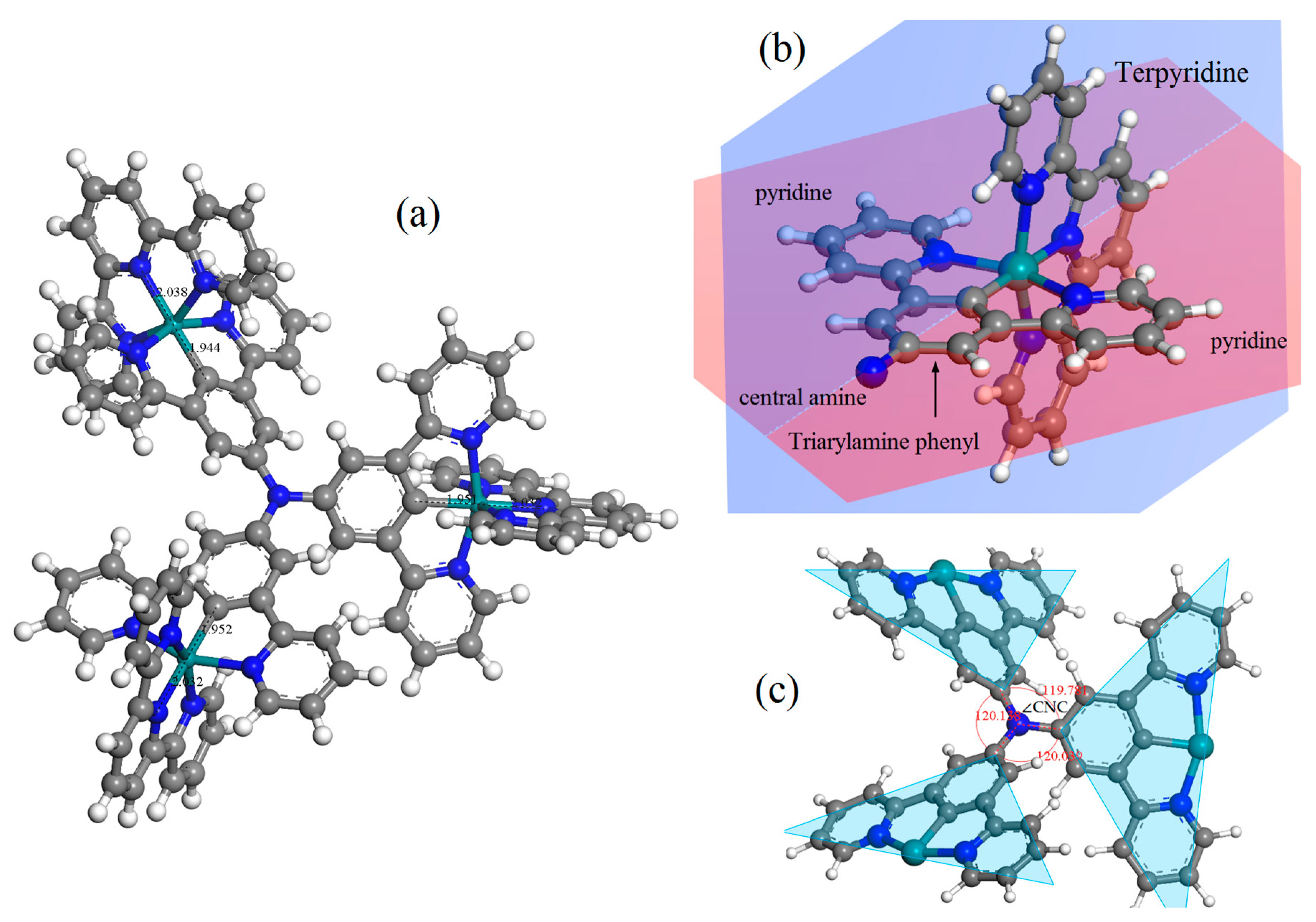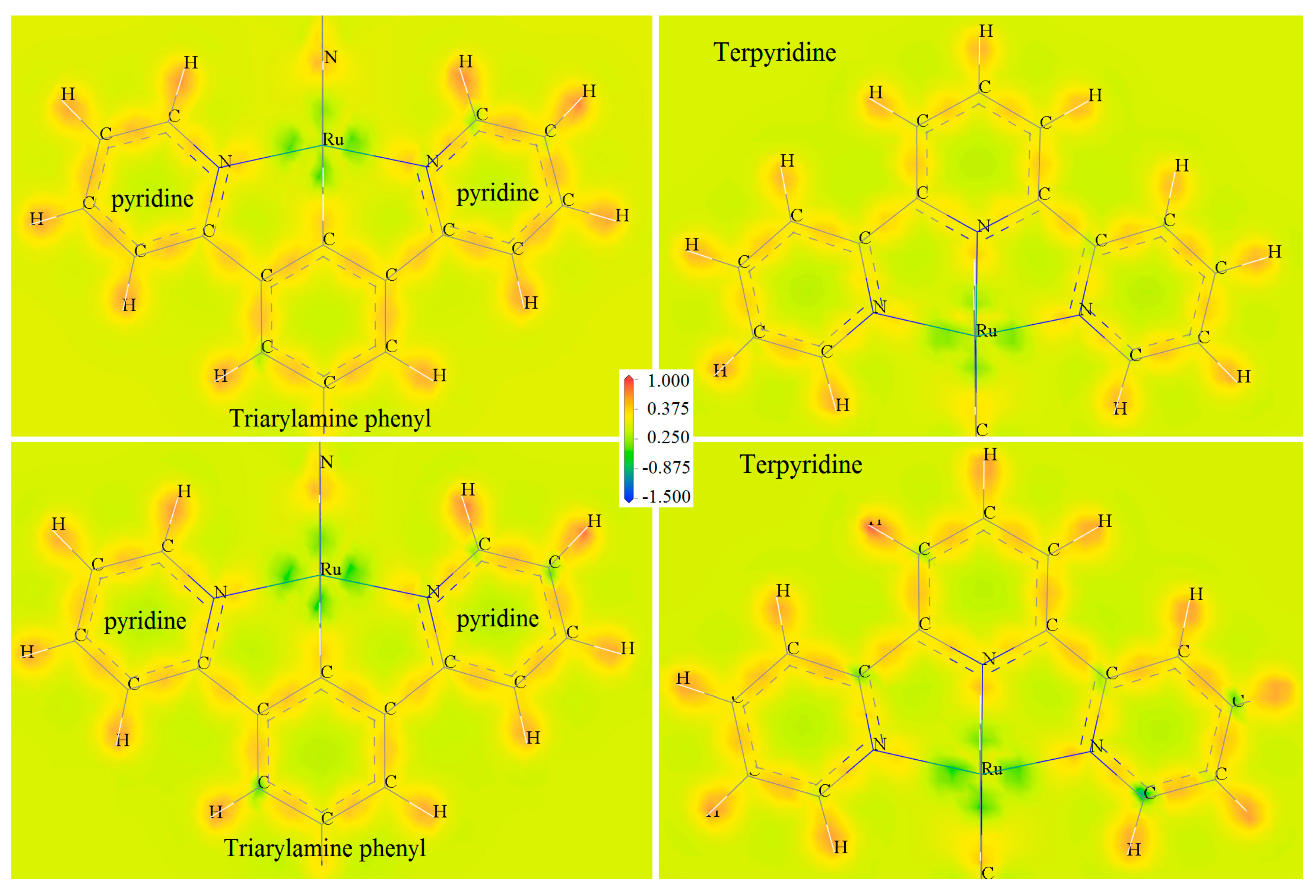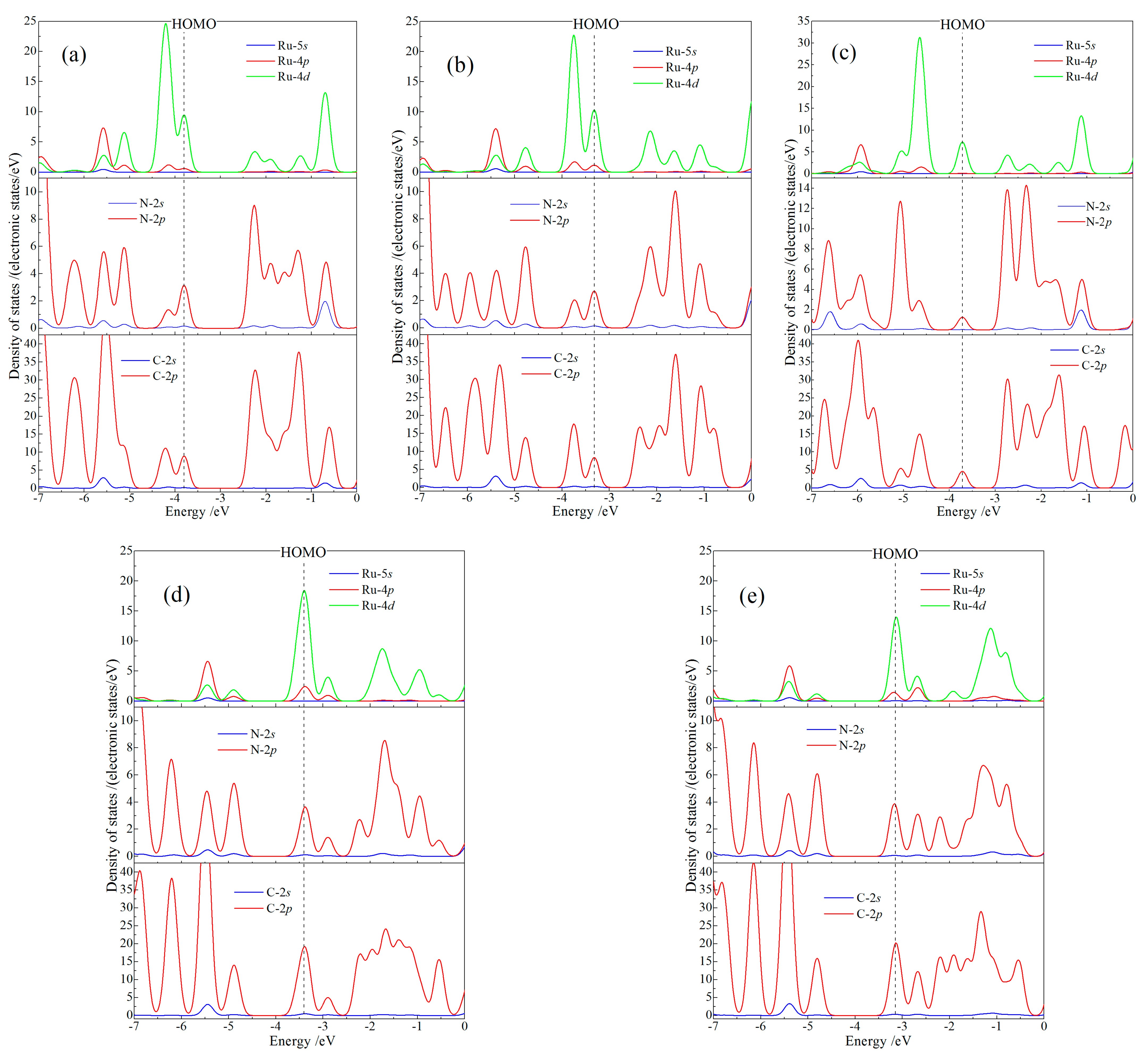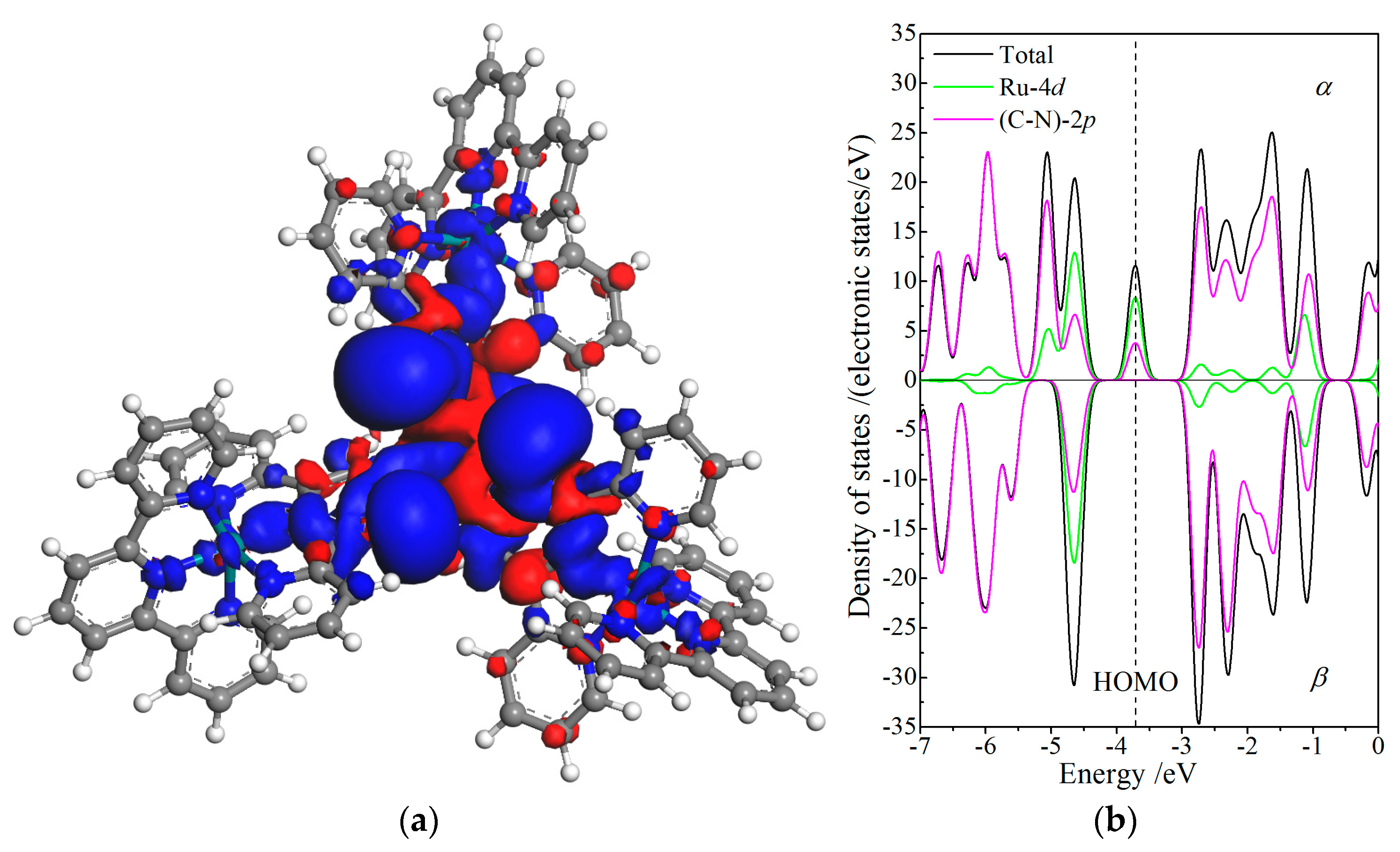First-Principles Study on Redox Magnetism and Electrochromism of Cyclometalated Triarylamine-Core Triruthenium Complex
Abstract
:1. Introduction
2. Theoretical Calculation Methodology
3. Results and Discussion
3.1. Molecule Structure
3.2. Multistate Redox Mechanism
3.3. Electronic Orbitals and Density of States
3.4. Magnetic Property
3.5. Optical Absorption Spectrum
4. Conclusions
Author Contributions
Funding
Informed Consent Statement
Data Availability Statement
Conflicts of Interest
References
- Carpi, F.; Rossi, D.D. Colours from electroactive polymers: Electrochromic, electroluminescent and laser devices based on organic materials. Optic. Laser Technol. 2006, 38, 292–305. [Google Scholar] [CrossRef]
- Cui, B.B.; Nie, H.J.; Yao, C.J.; Yao, C.J.; Shao, J.Y.; Zhong, Y.W. Reductive electropolymerization of bis-tridentate ruthenium complexes with 5,5″-divinyl-4′-tolyl-2,2′:6′,2″-terpyridine. Dalton Trans. 2013, 42, 14125–14133. [Google Scholar] [CrossRef] [PubMed]
- Abidin, T.; Zhang, Q.; Wang, K.L.; Liaw, D.J. Recent advances in electrochromic polymers. Polymer 2014, 55, 5293–5304. [Google Scholar] [CrossRef]
- Shao, J.Y.; Yao, C.J.; Cui, B.B.; Gong, Z.L.; Zhong, Y.W. Electropolymerized films of redox-active ruthenium complexes for multistate near-infrared electrochromism, ion sensing, and information storage. Chin. Chem. Lett. 2016, 27, 1105–1114. [Google Scholar] [CrossRef]
- Tang, J.H.; Yao, C.J.; Zhong, Y.W.; Cui, B.B. Ruthenium-amine conjugated organometallic materials for multistate near-IR electrochromism and information storage. Chem. Rec. 2016, 16, 754–767. [Google Scholar] [CrossRef] [PubMed]
- Simao, C.; Mas-Torrent, M.; Casado-Montenegro, J.; Otón, F.; Veciana, J.; Rovira, C. A three-state surface-confined molecular switch with multiple channel outputs. J. Am. Chem. Soc. 2011, 133, 13256–13259. [Google Scholar] [CrossRef]
- Yoshida, M.; Yashiro, N.; Shitama, H.; Kobayashi, A.; Kato, M. A redox-active dinuclear platinum complex exhibiting multicolored electrochromism and luminescence. Chem. A Euro. J. 2015, 22, 491–495. [Google Scholar] [CrossRef] [Green Version]
- Norel, L.; Tourbillon, C.; Warnan, J.; Pellegrin, Y.; Miomandre, F.; Odobel, F.; Rigaut, S. Redox-driven porphyrin based systems for new luminescent molecular switches. Dalton Trans. 2018, 47, 8364–8374. [Google Scholar] [CrossRef]
- Lim, H.; Seo, S.; Pascal, S.; Bellier, Q.; Rigaut, S.; Park, C.; Shin, H.; Maury, O.; Andraud, C.; Kim, E. NIR electrofluorochromic properties of aza-boron-dipyrromethane dyes. Sci. Rep. 2016, 6, 1–8. [Google Scholar]
- Uflyand, I.E.; Dzhardimalieva, G.I. Molecular design of supramolecular polymers with chelated units and their application as functional materials. J. Coor. Chem. 2018, 71, 1271–1356. [Google Scholar] [CrossRef]
- Banasz, R.; Walesa-Chorab, M. Polymeric complexes of transition metal ions as electrochromic materials: Synthesis and properties. Coor. Chem. Rev. 2019, 389, 1–18. [Google Scholar] [CrossRef]
- Mas-Torrent, M.; Rovira, C.; Veciana, J. Surface-confined electroactive molecules for multistate charge storage information. Adv. Mater. 2013, 25, 462–468. [Google Scholar] [CrossRef] [PubMed]
- Wang, H.; Barrett, M.; Duane, B.; Gu, J.; Zenhausen, F. Materials and processing of polymer-based electrochromic devices. Mater. Sci. Eng. B 2018, 228, 167–174. [Google Scholar] [CrossRef]
- Laschuk, N.O.; Obua, A.; Ebralidze, I.I.; Fruehwald, H.M.; Poisson, J.; Egan, J.G.; Gaspari, F.; Naumkin, F.Y.; Easton, E.B.; Zenkina, O.V. Spacer conjugation and surface support effects in monolayer electrochromic materials. ACS Appl. Electron. Mater. 2019, 1, 1705–1717. [Google Scholar] [CrossRef]
- Yao, C.J.; Zhong, Y.W.; Nie, H.J.; Abruña, H.D.; Yao, J.N. Near-IR electrochromism in electropolymerized films of a biscyclometalated ruthenium complex bridged by 1,2,4,5-tetra(2-pyridyl)benzene. J. Am. Chem. Soc. 2011, 133, 20720–20723. [Google Scholar] [CrossRef] [PubMed]
- Grelaud, G.; Cifuentes, M.P.; Schwich, T.; Argouarch, G.; Petrie, S.; Stranger, R.; Paul, F.; Humphrey, M.G. Multistate redox-active metalated triarylamines. Eur. J. Inorg. Chem. 2012, 145, 65–75. [Google Scholar] [CrossRef]
- Shen, J.J.; Zhong, Y.W. Long-range ruthenium-amine electronic communication through the para-oligophenylene wire. Sci. Rep. 2015, 5, 13835. [Google Scholar] [CrossRef] [Green Version]
- Zhong, Y.W.; Gong, Z.L.; Shao, J.Y.; Yao, J.N. Electronic coupling in cyclometalated ruthenium complexes. Coord. Chem. Rev. 2016, 312, 22–40. [Google Scholar] [CrossRef]
- Qian, G.; Wang, Z.Y. Near-infrared organic compounds and emerging applications. Chem. Asian J. 2010, 5, 1006–1029. [Google Scholar] [CrossRef]
- Polit, W.; Exner, T.; Wuttke, E.; Winter, R.F. Vinylruthenium-triarylamine conjugates as electroswitchable polyelectrochromic NIR dyes. Bioinorg. React. Mech. 2012, 8, 85–105. [Google Scholar] [CrossRef]
- Nagashima, T.; Ozawa, H.; Suzuki, T.; Nakabayashi, T.; Kanaizuka, K.; Haga, M.A. Photoresponsive molecular memory films composed of sequentially assembled heterolayers containing ruthenium complexes. Chem. Eur. J. 2016, 22, 1658–1667. [Google Scholar] [CrossRef] [PubMed]
- Siepmann, J.I.; Frenkel, D. Configurational bias Monte Carlo: A new sampling scheme for flexible chains. Mol. Phys. 1992, 75, 59–70. [Google Scholar] [CrossRef] [Green Version]
- Tang, J.H.; He, Y.Q.; Shao, J.Y.; Gong, Z.L.; Zhong, Y.W. Multistate redox switching and near-infrared electrochromism based on a star-shaped triruthenium complex with a triarylamine core. Sci. Rep. 2016, 6, 35253. [Google Scholar] [CrossRef] [PubMed] [Green Version]
- Delley, B. From molecules to solids with the DMol3 approach. J. Chem. Phys. 2000, 113, 7756–7764. [Google Scholar] [CrossRef]
- Andzelm, J.; King-smith, R.D.; Fitzgerald, G. Geometry optimization of solids using delocalized internal coordinates. Chem. Phys. Lett. 2001, 335, 321–326. [Google Scholar] [CrossRef]
- Perdew, J.P.; Ruzsinszky, A.; Csonka, G.I.; Vydrov, O.A.; Scuseria, G.E.; Constantin, L.A.; Zhou, X.; Burke, K. Restoring the density-gradient expansion for exchange in solids and surfaces. Phys. Rev. Lett. 2008, 100, 136406. [Google Scholar] [CrossRef] [Green Version]
- Chantis, A.N.; Christensen, N.E.; Svane, A.; Cardona, M. Full-zone analysis of relativistic spin splitting at band anticrossings: The case of zinc-blende semiconductors. Phys. Rev. B 2010, 81, 205205. [Google Scholar] [CrossRef]
- Kresse, G.; Furthmüller, J. Efficient iterative schemes for ab initio total-energy calculations using a plane-wave basis set. Phys. Rev. B 1996, 54, 11169. [Google Scholar] [CrossRef]
- Baker, J.; Kessi, A.; Delley, B. The generation and use of delocalized internal coordinates in geometry optimization. J. Chem. Phys. 1996, 105, 192–212. [Google Scholar] [CrossRef]
- Tkatchenko, A.; Scheffler, M. Accurate molecular van der Waals interactions from ground-state electron density and free-atom reference data. Phys. Rev. Lett. 2009, 102, 073005. [Google Scholar] [CrossRef] [Green Version]
- Delley, B. Time dependent density functional theory with DMol3. J. Phys. D Condens. Matter. 2010, 22, 384208. [Google Scholar] [CrossRef] [PubMed]







| Redox State | Mean Bonding Length/Å | Mean ∠CNC/° | Triarylamine Dihedral Angle/° | Total Energy/Ha | Coordinating Energy/Ha | ||
|---|---|---|---|---|---|---|---|
| C-N | Ru-C | Ru-N | |||||
| +2 | 1.414 | 1.948 | 2.026 | 119.979 | 27.60/36.86/43.45 | −17759.64085 | 1.4289 |
| +3 | 1.416 | 1.944 | 2.034 | 119.986 | 27.66/36.92/43.54 | −17759.64275 | 1.4276 |
| +4 | 1.417 | 1.952 | 2.037 | 119.963 | 27.63/36.90/43.51 | −17759.64295 | 1.4265 |
| +5 | 1.419 | 1.949 | 2.025 | 119.998 | 27.54/36.68/43.36 | −17759.64078 | 1.4296 |
| +6 | 1.420 | 1.948 | 2.058 | 120.011 | 27.38/36.46/43.07 | −17759.63343 | 1.4171 |
| Redox State | λm/nm | Em/eV | Os/a.u. | Molecular Orbital Level/eV | Orbital Overlap | |
|---|---|---|---|---|---|---|
| From | To | |||||
| +2 | 528 | 2.35 | 0.09 | −5.08 | −2.72 | 0.41 |
| +3 | 493 | 2.52 | 0.29 | −3.32 | −1.09 | 0.50 |
| +4 | 464 | 2.67 | 0.16 | −3.86 | −1.24 | 0.39 |
| +5 | 519 | 2.39 | 0.27 | −3.34 | −1.84 | 0.77 |
| 459 | 2.70 | 0.25 | −3.47 | −1.00 | 0.59 | |
| +6 | 399 | 3.11 | 0.18 | −4.86 | −1.96 | 0.47 |
Publisher’s Note: MDPI stays neutral with regard to jurisdictional claims in published maps and institutional affiliations. |
© 2021 by the authors. Licensee MDPI, Basel, Switzerland. This article is an open access article distributed under the terms and conditions of the Creative Commons Attribution (CC BY) license (http://creativecommons.org/licenses/by/4.0/).
Share and Cite
Li, L.; Wang, Y.; Chen, M.-Y.; Zhang, J.; Liang, J.-Q.; Liu, H.-Q.; Sun, Y.-X.; Song, W.; Sun, W.-F. First-Principles Study on Redox Magnetism and Electrochromism of Cyclometalated Triarylamine-Core Triruthenium Complex. Crystals 2021, 11, 57. https://doi.org/10.3390/cryst11010057
Li L, Wang Y, Chen M-Y, Zhang J, Liang J-Q, Liu H-Q, Sun Y-X, Song W, Sun W-F. First-Principles Study on Redox Magnetism and Electrochromism of Cyclometalated Triarylamine-Core Triruthenium Complex. Crystals. 2021; 11(1):57. https://doi.org/10.3390/cryst11010057
Chicago/Turabian StyleLi, Lin, Yue Wang, Meng-Yang Chen, Jian Zhang, Jian-Quan Liang, He-Qian Liu, Yu-Xuan Sun, Wei Song, and Wei-Feng Sun. 2021. "First-Principles Study on Redox Magnetism and Electrochromism of Cyclometalated Triarylamine-Core Triruthenium Complex" Crystals 11, no. 1: 57. https://doi.org/10.3390/cryst11010057
APA StyleLi, L., Wang, Y., Chen, M.-Y., Zhang, J., Liang, J.-Q., Liu, H.-Q., Sun, Y.-X., Song, W., & Sun, W.-F. (2021). First-Principles Study on Redox Magnetism and Electrochromism of Cyclometalated Triarylamine-Core Triruthenium Complex. Crystals, 11(1), 57. https://doi.org/10.3390/cryst11010057





